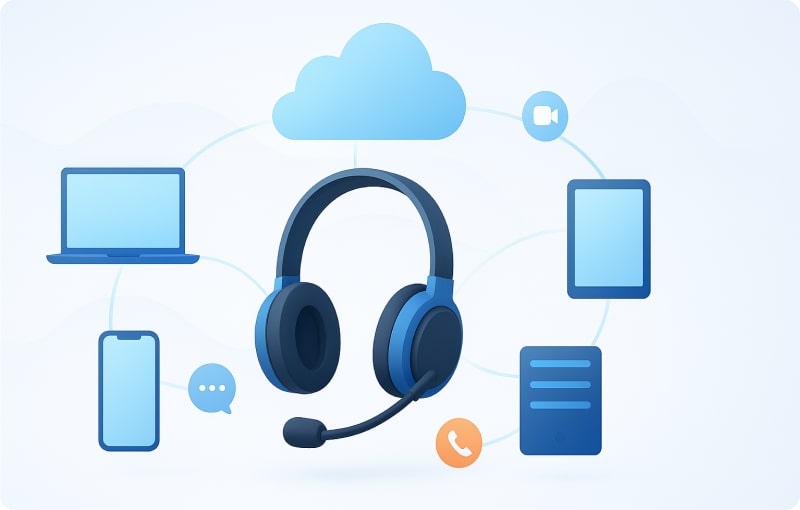
What is call center software, really? In simple terms, it’s a software system designed to help businesses manage all their customer calls and queries from one centralized system. But in 2025, call center software is no longer just about answering calls; it is about unifying customer engagement tools like voice, chat, video, and social messaging into one hub, empowered by AI, automation, and real-time analytics.
The modern customer expects more than quick responses – they want personalized, consistent, and seamless experiences. At the same time, the growth of remote and hybrid work culture has pushed businesses to adopt flexible, cloud-based solutions that keep distributed teams connected and productive.
Let’s understand this in more depth.
What is Call Center Software?
At its simplest, a call center software is a replacement for manual call handling or traditional desk phones used by businesses to manage customer communications. Such a platform streamlines various processes, including call routing, call queuing, agent management, and reporting – all in one place. This benefits organizations in several ways as they are able to deliver faster responses, reduce missed calls, increase work efficiency, and provide a more professional experience to their customers.
On-Premise vs. Cloud-Based Call Center Phone Systems

Traditionally, call centers relied on on-premise phone systems with physical servers and hardware equipment installed within the company’s premises. These systems offered solid control and reliability; however, they often required heavy upfront investment, ongoing maintenance, and in-house IT expertise.
On the contrary, cloud-based call center systems rely entirely on the internet. While the need to maintain expensive on-premise infrastructure gets eliminated, because everything is hosted and managed by the service provider. These systems offered additional benefits, including high scalability, cost efficiency, and flexibility, which allowed teams to operate from anywhere, whether in-office or remotely. Moreover, cloud-based call center solutions have features like AI-driven analytics, CRM integration, and real-time reporting, making them the preferred choice for modern enterprises.
Types of Call Center Solutions
Call center software is primarily categorized into 3 types based on business needs:
1. Inbound Call Centers
These call center systems focus on handling incoming calls from customers, often for customer support, help desks, or service queries. These are ideal for e-commerce companies, banks and financial institutions, healthcare and insurance, etc.
2. Outbound Call Centers
Opposite to Inbound, the outbound call center solutions are primarily used for placing calls to customers or prospects. These are ideal for sales, telemarketing agencies, real estate, travel agencies, or proactive customer outreach.
3. Blended Call Centers
With the combined capabilities of both inbound and outbound operations on a single platform, blended call center solutions allow agents to handle calls in both directions as needed. These solutions give businesses the flexibility to balance service and sales functions, enhancing agent productivity and improving services.
Key Features to Look For in a Call Center Solution

There are so many providers and technologies available in the market. It is quite overwhelming for any business owner to choose the right call center solution. So what’s the best way to ensure success? Well, focus on a solution with the features that meet your business needs today and grow with you tomorrow. Below are the essential capabilities every modern call center phone system should include:
1. Omnichannel Communication
Today’s customers expect to connect with businesses on the channel they prefer. It can be through voice, email, WhatsApp, live chat, or even social media platforms. This is the reason why modern call center solutions bring all these touchpoints into a single interface, allowing agents to seamlessly manage omnichannel communications with customers.
2. Call Routing & IVR
At its core, the efficiency of a call center software lies in its ability to ensure that customer calls reach the right agent or department quickly. Modern call center platforms offer intelligent call routing based on agent skills, availability, or customer history. While this helps in minimizing customer wait times, it also reduces call transfers and improves first-call resolution rates
3. Analytics & Reporting
Behind every successful call center operation is its data that provides key insights. With live dashboards, performance metrics, and historical trends, analytics and reporting enable managers to identify bottlenecks and improve decision-making.
4. Third-Party Integrations
It is important to understand that a call center doesn’t operate in isolation. The best solutions integrate seamlessly with existing business tools like CRM platforms and ERP software. Such an integration allows agents to have a complete customer context during every interaction, enabling personalized service and reducing resolution times.
5. Security & Compliance
With the ever-rising concerns around data privacy, compliance is non-negotiable. A reliable call center solution should adhere to international and local regulations like GDPR, HIPAA, and PCI DSS, depending on the industry. Built-in features such as end-to-end encryption, role-based access controls, and secure call recording help protect sensitive customer information.
Benefits of Using Modern Call Center Applications

Rising customer expectations, remote workforces, and global competition have made contact centers one of the most pressured parts of a business. However, the best thing about modern call center applications is that they flip this pressure into opportunity. Businesses are able to scale, save costs, personalize services, resolve queries faster, and turn one-time buyers into lifelong advocates.
1. Lower Costs vs. Traditional Systems
Traditional PBX-based call center systems require high investment for hardware, maintenance, and IT staff to keep things operational. However, cloud-based call center solutions solved this problem with almost zero upfront infrastructure and predictable subscription pricing – yes, that’s true. Numbers back this up – A report by Accenture found that moving workloads to the public cloud can lead to a Total Cost of Ownership (TCO) savings of 40%. Source
Additionally, cloud solutions eliminate the hassle of downtime caused by hardware failures, saving both money and customer trust.
2. Improved Customer Experience

Today, businesses can’t expect customers to explain their issue three times or wait on hold for 20 minutes. Modern call center software unifies business-customer interactions across voice, chat, email, social media, and WhatsApp into a single journey. This means call center agents have the full context at their fingertips, which expedites response times and adds a personalized touch to every interaction.
3. Remote-Ready (Cloud Flexibility)
Call center agents work from the comfort of their place – Thanks to cloud-based call center phone systems that allow them to log in from anywhere with nothing more than a laptop and a headset. Even managers can monitor and measure agent performance in real-time. Such flexibility also helps businesses to tap into global talent pools – a business in New York can have customer support agents in Cape Town without missing a beat.
4. Scalability for SMEs & Enterprises
Startups often operate on a tight budget. However, with modern call center applications offering pay-as-you-go pricing, startups can leverage call center software without facing any budget issues. A small business can start with just 5 agents and scale up to 500 as they expand – no heavy additional investment.
Enterprises also benefit from scalability by handling seasonal surges such as festive sales or holiday discounts without compromising quality or speed.
5. Access to AI-Driven Insights
With the integration of AI, call center applications have become a proactive tool for businesses to enhance their operations. AI chatbots and voice bots have become frontline agents. They can handle routine queries like order tracking, password resets, or billing questions instantly, freeing human agents to focus on complex cases.
Voice bots equipped with natural language processing (NLP) can detect tone, intent, and even customer frustration, escalating calls to live agents when needed. Chatbots, meanwhile, provide 24/7 support across websites, mobile apps, WhatsApp, and social channels, ensuring no customer is left waiting.
Best Call Center Software Providers in 2025
While there are many, here we are going to discuss the top three standout options among all.
Provider 1 – REVE Cloud PBX & Call Center Software
REVE offers a cloud PBX and call center solution designed especially for service providers, telcos, and enterprises seeking customizable, white-label communication platforms. This call center solution focuses on combining voice, video, messaging, and virtual PBX capabilities in one flexible platform. It is built over secure cloud infrastructure, offering global reach with strong support.
Key Features:
- Cloud-based PBX and full call center functionality: omnichannel voice, messaging, and video
- White-label capability & branding customization for service providers
- Powerful AI Voicebot and chatbot support
- AI enhancements like voice suppression, virtual roaming, and softswitch capabilities
- Use case-based pricing rather than heavy upfront infrastructure costs
- Fast-track ticketing system integrated with the solution
- Multi-device support across browser, mobile, IP phone, and PSTN number
Pricing Style
Because REVE is designed for service providers, there are custom enterprise plans for high volume / global usage.
What makes it stand out among call center software providers
REVE is excellent for those who want a provider that can do both PBX & full call center capabilities, especially in cloud environments. The white-label edge gives it an advantage for providers who want to offer a branded solution.
Provider 2: Genesys Cloud CX
Genesys Cloud CX is one of the most mature cloud call center platforms in the market. Known for its enterprise-grade reliability, flexibility, and strong AI and analytics capabilities. It supports omnichannel engagement and has a large ecosystem of integrations.
Key Features:
- Advanced AI tools: predictive routing, sentiment analysis, workforce engagement, and real-time dashboards
- Omnichannel support: voice, chat, email, messaging apps
- Integrations with CRM and ERP systems, robust developer / API support
- High reliability and SLAs are typical of enterprise-grade providers
Pricing Style
Tiered subscription model. Example: Genesys Cloud CX voice + digital + workforce engagement modules. Prices start at around US$75–155 per user/month, depending on channels, features, and scale.
What makes it stand out among call center software providers
It excels when you need very strong analytics + AI + scalability. If your organization expects to scale massively or needs deep reporting & compliance, this is often a top choice.
Provider 3 – Talkdesk
Overview: Talkdesk is another strong cloud-based call center application, popular with businesses that need fast deployment, good UX, and solid automation. It combines omnichannel capabilities with ease of use, especially for mid-sized teams and teams growing rapidly.
Key Features:
- Intuitive agent interface & quick onboarding
- Real-time analytics and reporting dashboards
- Automation tools: IVR, self-service, chatbots, AI-aided tools for agent assist
- Strong integrations (CRM, workflow tools) to lower friction
Pricing Style
Mid-tier subscription pricing with different plans based on agents and features. More advanced features (AI/analytics / WFM) cost more. Good for teams that need reliability without huge enterprise budgets.
What makes it stand out among call center software providers
Talkdesk offers a sweet spot between capability & cost. It’s a good balance if you want modern cloud-based call center phone systems, with performance and useful features, but without overpaying for enterprise-only scale.
Comparison of Leading Call Center Management Solutions
| Provider | Best For | Strengths | Considerations |
| REVE | Service providers / Telcos/enterprises wanting PBX + CCaaS capabilities | White-label, telecom strength, cloud PBX + call center, global focus | Might need more integration work depending on region; smaller support bases in some regions vs global giants |
| Genesys Cloud CX | Large enterprises needing deep analytics, AI, and compliance | High reliability, powerful AI, broad integrations | Higher cost; steeper learning curve, more feature complexity |
| Talkdesk | Mid-sized organizations scaling up, wanting UX + automation | Good UI/UX, fast deployment, strong omnichannel features | Some advanced features are behind higher tiers; costs rise as you add AI / WFM modules |
How to Choose the Right Call Center Software

Choosing the wrong call center software can slow down your business, while the right one can turn your contact center into a growth engine. Here’s a framework I recommend when advising clients:
Step 1: Define Business Needs
Start with your pain points. Ask yourself these questions:
- Are your agents wasting time toggling between tools?
- Are customers abandoning calls because of long IVR trees?
- Is compliance your top concern?
Map all your pain points into business goals and then decide which solution aligns the best.
Step 2: Distinguish ‘Must-Haves’ from ‘Nice-to-Haves’
Decide on the essentials and the optional ones. For the must-haves, omnichannel communication, call routing, and analytics dashboards could be your options. And then for the “Nice-to-haves”, you may think of some advanced features. This clarity will help you get the best value from your choice.
Step 3: Evaluate Support, Reliability, & Compliance
Most businesses make the mistake of focusing on what the software can do and forgetting about how consistently it delivers. Therefore, ask:
- Does the provider have 99.99% uptime guarantees?
- Do they support global compliance like GDPR or PCI DSS?
- What happens at midnight when your system crashes – do you get instant support?
Step 4: Check Scalability and Pricing
Another common mistake businesses make – buying for today, not for tomorrow. You might need only 5 agents today, but soon you could scale to 100. Here, Cloud-based call center phone systems shine because you can add or remove users instantly without a heavy upfront investment.
Also, be sure to evaluate pricing models, such as per-user, per-minute, or bundled. Remember that the plans with a lower cost aren’t always the most cost-efficient when you grow.
Step 5: Don’t Just Read About It
It is good to download brochures and watch videos of the solution you find suitable; however, doing so doesn’t tell you how it really works for your business. Always run a pilot or free trial. See how your agents feel using it. Can supervisors pull real-time reports without calling IT? How fast can you onboard a new agent? A week-long trial will reveal more than hours of sales pitches.
In the end, choosing the best call center software is about who helps you serve your customers better, faster, and smarter.
Last Words
If you’re exploring how to launch or optimize your call center operations, REVE Systems is here to help. Our team has years of experience empowering telecom operators with carrier-grade communication platforms tailored to their needs. Whether you need expert guidance on setup, integration, or scaling your services, we’ll work closely with you to design a solution that fits your goals. Book your free consultation.
Frequently Asked Questions
Which industries benefit most from call center software?
E-commerce & retail, Banking & finance, Healthcare, Travel & hospitality, IT & SaaS companies
Can call center solutions handle international calling?
Yes, most support local and international DID numbers, global routing, and multi-language IVR.
Do all call center providers offer AI chatbots and voice bots?
Not all. Advanced providers like REVE Cloud PABX & Call Center Software include AI-powered chatbots and voice bots for 24/7 automation.
What’s the difference between inbound and outbound call center software?
Inbound focuses on handling customer queries, while outbound handles telemarketing, sales, collections, and surveys. Some platforms combine both.
What are the benefits of using call center applications?
Faster response times, better customer experience, centralized reporting, agent productivity tracking, and cost savings with cloud deployment.






















